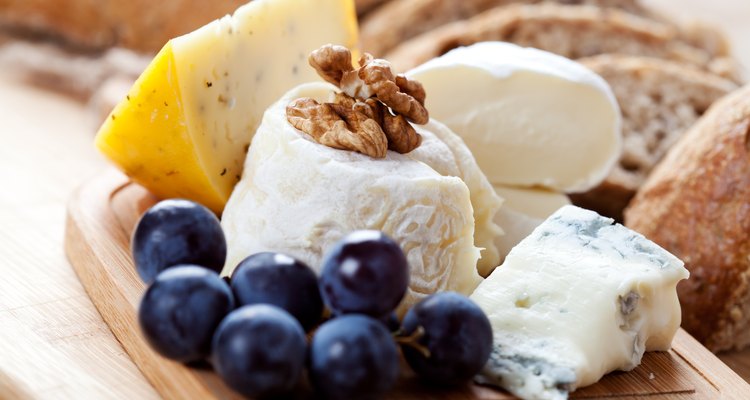
Natalia Van Doninck/iStock/Getty Images
Cheese is generally a high-fat food, depending on the type you’re eating. Because cheese is high in saturated fat – which increases your risk for heart disease when consumed in excess -- eat cheese in moderation or replace it with other protein-rich foods containing heart-healthy fats.
Fat in Cheese
Regular cheese is a high-fat choice. For example, one slice of cheddar cheese contains 9 grams of fat and one slice of provolone cheese provides 7 grams of dietary fat. Choosing part-skim, low-moisture mozzarella cheese means you’re getting about 6 grams of total fat per slice, the USDA notes.The majority of fat grams in each of these types of cheese is saturated fat, which increases your risk for high cholesterol and heart disease when consumed in excess.
Reduced-Fat Cheese
Choosing reduced-fat cheese instead of regular cheese is an excellent way to reduce the fat – and calorie – content of your diet. The USDA reports that one slice of reduced-fat cheddar cheese contains about 4 grams of fat, and one slice of reduced-fat provolone cheese provides just under 5 grams of dietary fat. Although the total fat content of reduced-fat cheese is lower than regular cheese, the majority of fat in reduced-fat cheese is still saturated fat.
Daily Fat Requirements
The percentage of calories in your diet that should be from fat is 20 to 35 percent, according to the Institute of Medicine. For example, if you eat 2,000 calories a day, 400 to 700 of those calories should be from fat, which equals 44 to 78 grams of fat daily. The Dietary Guidelines for Americans 2010 suggest obtaining less than 10 percent of your daily calories from saturated fat.
Healthy Alternatives
Choosing dietary fat from plant-based foods instead of from animal sources such as cheese helps reduce your saturated fat and dietary cholesterol intake. Examples of heart-healthy fats include olive, canola, soybean, flaxseed and walnut oils, olives and avocados. Foods that are rich in both heart-healthy fats and dietary protein include unsalted nuts and seeds and nut butters – therefore, these foods are heart-healthy alternatives to cheese.
Related Articles

The Best Cellulite Reducers
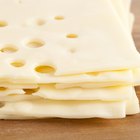
Nutrition in Swiss Vs. American Cheese

Swiss vs. Cheddar Cheese Nutrition ...

How Much Fat Is in Feta Cheese?
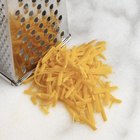
How Many Calories Are in 1/4 Cup of ...

The Calories in Garbanzo Beans
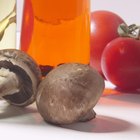
Mineral Oil Vs. Olive Oil

How Much Whole Grain Should You Eat a ...

Fresh Mozzarella vs. Regular Mozzarella ...
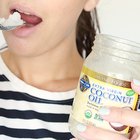
Skin Benefits of Eating Coconut Oil

Foods to Avoid to Prevent Gout

Peanuts Vs. Pistachios
The Calories in Seafood Paella

How to Freeze Empanadas

High Fiber & Protein Diet Menus

Which Is Healthier, Lima Beans or ...

Vitamins for Mental Alertness

Which Cooking Oil Can You Use on the ...

Nutrition Information on Blueberries
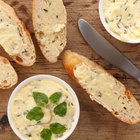
Buttered Toast & Bodybuilding
References
- U.S. Department of Agriculture National Nutrient Database for Standard Reference: Basic Report: 01009, Cheese, Cheddar
- U.S. Department of Agriculture National Nutrient Database for Standard Reference: Basic Report: 01035, Cheese, Provolone
- U.S. Department of Agriculture National Nutrient Database for Standard Reference: Basic Report: 01029, Cheese, Mozzarella, Part Skim Milk, Low Moisture
- U.S. Department of Agriculture National Nutrient Database for Standard Reference: Basic Report: 01260, Cheese, Cheddar, Reduced Fat
- U.S. Department of Agriculture National Nutrient Database for Standard Reference: Basic Report: 01208, Cheese, Provolone, Reduced Fat
- U.S. Department of Agriculture, U.S. Department of Health and Human Services: Dietary Guidelines for Americans 2010
Writer Bio
Erin Coleman is a registered and licensed dietitian. She also holds a Bachelor of Science in dietetics and has extensive experience working as a health writer and health educator. Her articles are published on various health, nutrition and fitness websites.
Photo Credits
Natalia Van Doninck/iStock/Getty Images